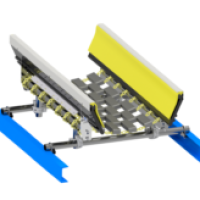Statics Loading table - SPARGA & SPARGAET
Optimisation & Amélioration
Loading table - SPARET EX
The new SPARET EX loading point is made with Polyethylene sliding bars fixed to the support stations. It is designed to directly replace the rollers under the transfer areas.
- Products Features
- Features
- SPARET EX consists of Polyspar bars mounted on roller supports.
- The elimination of moving parts, good slipperiness, low wear and easy maintenance make SPARET EX a real asset.
- The SPARET EX is available for deep trough stations, flat stations and also with adjustable troughs.
- The SPARET EX is easily installed on the frames of new or renovated conveyors.
- Its use in a trough ensures good sealing of the loading points.
- It can be used without problems for grain sizes up to 30mm.
- Beyond this grain size, the SPARMAT range is more apropriate.
Optimisation & Amélioration
Deep trough loading table - SPARGAET EX
The SPARGAET eliminates traditional charging stations and systems. It eliminates the risks associated with particularly dangerous in-running angles at loading points. The SPARGAET facilitates the correct positioning of materials on the belt.
- Products Features
- Features
- The SPARGAET eliminates nip angles at the loading point.
- The SPARGAET has two degrees of freedom for fast, easy and precise adjustment:
- the flexibility of the belt (thanks to its position in relation to the blocks)
- the vertical movement of the chains during the fall of the material
- The SPARGAET is made up of flexible and independent Polyspar blocks, linked together by steel chains.
- The side rails of the SPARGAET make it possible to raise the belt and form a trough at 65°, thus eliminating the metal trough.
- The SPARGAET improves the centering of the belt.
- SPARGAET is available for belt widths from 500 to 1000 mm.
- SPARGAET can be used for grain sizes up to 100 mm (please consult us for larger sizes).
- The transition and troughing area should be 1.5 to 2 times the width of the belt, depending on belt type and speed.




